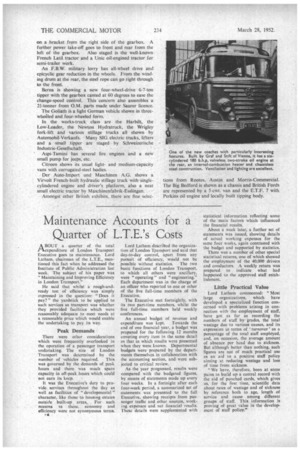Maintenance Accounts for a Quarter of L.T.E.'s Costs
Page 46

If you've noticed an error in this article please click here to report it so we can fix it.
A BOUT a quarter of the total expenditure of London Transport Executive goes to maintenance. Lord Latham, chairman of the L.T.E., mentioned this fact when he addressed the Institute of Public Administration last week. The subject of his paper was Maintaining and Improving Efficiency in London Transport."
He said that whilst a rough-andready test of efficiency was simply expressed in the question: "Does it pay?" the yardstick to be applied to such services as transport was whether they provided facilities which were reasonably adequate to meet needs at a reasonable price which would enable the undertaking to pay its way.
Peak Demands There were other considerations which were frequently overlooked in the operation of a passenger transport undertaking. The size of London Transport was determined by the
number of vehicles required. This was governed by the demands of peak hours and there. was mach spare capacity in off-peak hours which could not earn its keep.
It was the Executive's duty to provide services throughout the day as well as facilities of "developmental" character, like those tohousing estates outside built-up areas.. For such reasons as these, economy and efficiency were not synonymous terms.
Lord Latham described the orgailizalion of London Teansport and said that day-to-day control, apart from any .pursuit of efficiency, would not be
possible without statistics. The two basic functions of London Transport, to which all others were ancillary, were " operating " and "engineering." Each department was in the charge of an officer who reported to one or other of the five full-time members of the Executive.
The Executive met fortnightly, with its two part-time members, whilst the five full-time members held weekly conferences.
An annual budget of revenue and expenditure was kept. Towards the end of one financial year, a budget was prepared for the following 12 months covering every item in the same detail as that in which results were presented when they were known. Departmental budgets were prepared by the departments thernselses in collaboration with the accounting section, and were subjected to critical review.
As the year Progressed, results were compared. with the budgeted figures, by means of statements made up every four weeks. la a fortnight after each four-week period, a summarized set of statements was presented to the full Executive, showing receipts from passenger traffic and other .sources, working expenses and net financial results. These details were supplemented with
statisticalinformation reflecting some of the main factors which influenced the financial results.
About a week later, a further set of statements was issued, showing details of actual working expenses for the same four weeks, again contrasted with the budget and supported by statistics.
There was a number of other special statistical returns, one of which showed the employment of the 40,000 drivers and conductors. A weekly return was prepared to indicate what had happened to the approved staff establishment.
Little Practical Value Lord Latham commented: "Most large organizations, which have developed a specialized function concerned with problems arising in connection with the employment of staff, have got as far as recording the numbers of stall by-grades, the total wastage due to various causes, and its expression lel terms of 'turnover' as a percentage of the total staff empleyed, and, on occasion, the average amount of absence per head due to sickness. But although better than nothing, such figures are not of much practical use as an aid to a positive staff policy aiming at reducing wastage and loss of time from sickness.
"We have, theTefore, been at some pains to build up a central record with the aid of punched cards, which gives us. for the first lime, scientific data about rates of wastage and of sickness by reference both to age, length of service and cause among different groups Of staff. This information is proving .of great value in the development of staff policy."'




















































































